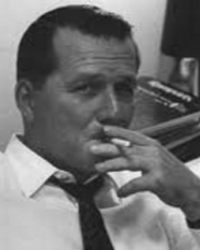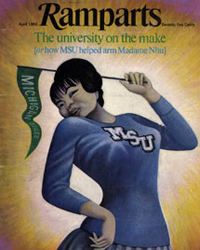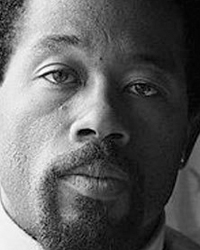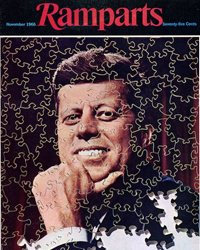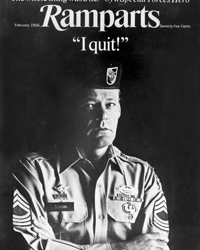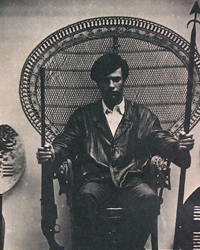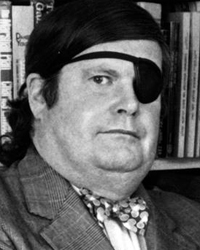 |
Warren Hinckle passed away on August 25th, at age 77. Hundreds at the Saints Peter and Paul Church in North Beach, San Francisco, attended his funeral service. He was buried on Tuesday the 30th. Some of the luminaries who attended his funeral were historian Kevin Starr, the founder of Salon David Talbot, and former San Francisco Mayor Willie Brown.
CTKA carried a notice upon his passing, one from the online version of the Chronicle, the paper he used to write for. Among several others, there were notices in the New York Times, The Nation, and the online magazine Politico. This author read most of them. Not one even came close to recalling or measuring the journalistic brilliance of the man, or the eternal glory of his most significant creation, the last great American magazine, Ramparts. Considering the standard set by that glossy monthly periodical, I understand the reluctance to remind us of Hinckle’s achievement.
For those too young to recall it, Ramparts is hard to describe. For the simple reason that there is nothing today that even resembles it. Which says a lot. Because today we live in the era of online publication; which means journals are much cheaper to produce and maintain, and therefore there is much more freedom to create. The fact that, to this day, no one has equaled Hinckle’s 1964-69 editorial achievement at Ramparts is what makes what he did the stuff of legend. After all, it was nearly half a century ago.
Edward Keating |
Before trying to detail the pure excitement that Ramparts represented, it is necessary to tell the reader a bit about Hinckle’s background. He was born in San Francisco in 1938. His father was a shipyard worker. He attended parochial schools before studying philosophy at the University of San Francisco. There he edited the student newspaper, The Foghorn. Under his editorship it became quite an unusual student newspaper. For instance, it was one of only 14 college newspapers classified as a daily. As editor of a daily, Hinckle went to Squaw Valley in Lake Tahoe for two weeks to cover the 1960 Winter Olympics. From Tahoe, he ran The Foghorn via telephone and telegraph. As he later noted, its readers read little about their college in the college newspaper. For Hinckle featured Herblock cartoons, and headlines like “Dorothy Day Asks: Who Baptized Capitalism?” (USF was a Jesuit college) He once stole the entire press run of the rival San Francisco State newspaper. Needless to say, because of disputes with the college administration, he left USF without graduating.
From there he took a job at the San Francisco Chronicle. His first outpost was in Oakland, which Hinckle called the Siberia of the Chronicle stations. Working the police beat, he discovered an unwritten rule about the paper’s Oakland coverage. The coverage of a homicide largely depended upon where the victim lived. To quote from his memoir: “Ghetto murders, being regarded as natural black events, were rarely considered newsworthy. White trash murders stood a poor to even chance of getting in the paper…..” There was also a rule of thumb similar to this in the area of fatal car accidents: “No niggers after 11 PM on weekdays, 9 PM on Saturdays (as the Sunday paper went to press early).” To this rule there was one exception, in the area of quantity: “If two black persons died in a late evening auto crash, that event had a fair chance of making the news columns.” (Hinckle,, If You Have a Lemon, Make Lemonade, pgs. 31-. 32)
Eventually, he made it back to San Francisco, where he was given a bit of leeway. One of his favorite stories was about a former slave from Alabama who emigrated to California. He got rich in the pinball machine business and legally adopted the children of his former master. Then, in the fall of 1961, Hinckle took a temporary leave of absence to help invigorate an ambitious and intellectual Catholic quarterly.
Hinckle had been moonlighting in the public relations business. A friend of his, Harry Stiehl, decided to introduce him to a man named Ed Keating. Keating was a converted Catholic who wanted to start a quarterly periodical that was meant to begin a dialogue between laity and the clergy of the Catholic Church. He also wanted to begin to spawn a new generation of Catholic intellectuals who had a gift for writing and communicating. With his PR connections, Stiehl thought Hinckle could help promote Keating’s new journal. It was called Ramparts.
Howard Gossage |
Keating had a wealthy wife and some famous contributors, like the Trappist monk Thomas Merton and John Griffin, who wrote the bestseller Black Like Me. In 1964, Keating tried to raise his journal’s profile by defending the highly controversial play The Deputy which had just opened on Broadway. Hinckle arranged a huge press conference in Keating’s suite at the Waldorf Astoria hotel. Keating and his magazine got exposure; the play opened successfully and ran for a year. As Hinckle wrote in his book, this episode became the model for what he later termed activist journalism.
It also increased the circulation of the magazine. Keating liked that and he appreciated what Hinckle had done. So Hinckle did it again. But this time he channeled all the PR into an issue that very much interested him—the murders of three civil rights workers in Neshoba County, Mississippi in June of 1964. Hinckle promoted a man named Louis Lomax as the Ramparts author of this sensational article. Lomax did not come through. But like the British at Dunkirk, Hinckle turned an expected disaster into a triumph by promising the details of the Lomax piece in a future issue. (Although Hinckle does not deal with this episode in his book, Peter Richardson does in his chronicle of the magazine, A Bomb in Every Issue.)
There were two factors that allowed Hinckle to gain control of the magazine from Keating. First, because of the success Hinckle had in promoting Ramparts, Keating made him executive editor. Second, Keating was becoming financially overextended. Or as he told Hinckle, “I do have one shopping center left.” (Hinckle, p. 95) Therefore Hinckle now had to find alternative sources of funding himself. Which he did. Thus began Hinckle’s five year reign. He was greatly aided by the PR skills and connections of one Howard Gossage. Gossage was an advertising executive in the Bay Area who was generally described as an innovator and iconoclast in the field. At age 36, he founded his own agency called Wiener and Gossage. He would often have salons at his office headquarters, inviting many of the cutting edge thinkers in the San Francisco area, including Hinckle. (Click here for more on Gossage http://www.howardluckgossage.com/)
To describe in detail the contents of what Hinckle produced in those five years would take a medium sized book. And I don’t mean the machinations that went on at the magazine headquarters, or just naming some of the big stories Ramparts produced. But to detail the contents of what the magazine exposed about America, who Hinckle decided to take on, the methods he employed and the price he was willing to pay, all these—and more—were, to my knowledge, unprecedented before him, and unmatched afterwards. Ramparts was so effective and influential that it became a regular target of the MSM, especially Time magazine and the New York Times, which obviously did not like being exposed as the poseurs they were. Beyond that, the CIA launched operations against Ramparts. These were commissioned by Desmond Fitzgerald, supervised by Richard Ober, and executed by Edgar Applewhite. As detailed in his book Secrets, the late Angus McKenzie showed how this program grew into MHCHAOS, the massive CIA spying on and infiltration of leftist protest groups in that decade.
Madame Nhu as depicted on cover of Ramparts |
What got the CIA so angry? For starters, Ramparts exposed a program the Agency was running out of Michigan State University. (Click here http://la.utexas.edu/users/hcleaver/357L/357LMSUinVietnam.pdf) It taught CIA interns how to train interrogators in South Vietnam to torture dissidents in Saigon. This created an uproar. Not just for the story, but also because of the hilariously outrageous Ramparts cover, which featured the immortal image of Madame Nhu in an MSU cheerleaders’ outfit waving an MSU flag. The image suggesting the Vietnam War was now controlling the agenda of American colleges. (Click here for a time capsule reaction http://msupaper.org/issues/The_Paper_1966-04-21.pdf)
Then there was Donald Duncan. Duncan was a Special Forces Sergeant who served in Vietnam and taught at Fort Bragg, North Carolina. He resigned his commission and returned to Berkeley, California. There, in February of 1966, Duncan graced another memorable Ramparts cover. He was pictured in a long sleeved uniform, topped with a Green Beret cap. Above him were the words, “I quit”. Above that was the quote: “The whole thing was a lie.” In this emblematic story, Duncan described his ten years in the military, capped by a nearly two year tour in Vietnam. He said he went to Vietnam to fight communism. But what he learned there about the American effort forced him to retire from the service forever. Duncan first focused on the fact that there really was no government of South Vietnam—it was simply constructed and propped up by the USA. And it was in no way a democracy. Secondly, he wrote that the Ho Chi Minh Trail was wildly overrated as a source of supplies for the Viet Cong. Most of the material came over the border or from the sea. Thirdly, he said that the US military was involved in atrocities that violated the rules of warfare, and this extended to the civilian population. Duncan was really the first former GI to open up the path for Mark Lane’s book Conversations with Americans, the Winter Soldier Hearings, and the exposure of the My Lai Massacre. (http://vietnamfulldisclosure.org/wp-content/uploads/2015/04/1966-02-Donald-W.-Duncan-The-Whole-Thing-Was-A-Lie-Ramparts.pdf)
In the March 1967 issue Hinckle exposed another instance of the CIA operating domestically. Ramparts now revealed that the Agency was secretly funding the National Students Association. (http://www.unz.org/Pub/Ramparts-1967mar-00029) In other words the largest college student association in America--featuring a large annual convention picturing a celebration of youthful democracy--was secretly funded, infiltrated and channeled by the Agency. Many of the top officers knew about it and were briefed on that association. Further, several of them had case officers, code names, and reporting requirements. Incredibly, some of their overseas representatives were actually career CIA agents from Langley. The aim of the program was multi-leveled. First, the Agency would moderate any radical or leftist tendencies in the largest student organization in the world. Second, they would use the overseas voyages of the students to collect information and try and moderate any radical leaders abroad. And third, the propaganda goal was to portray our young representatives as independent citizens, while many of the people they met abroad were communist stooges programmed from Moscow. (Hinckle, p. 185)
Eldridge Cleaver |
NSA officer Michael Wood had a pang of conscience about it and was talking to Hinckle. Unlike other top officers, Wood had not signed a non-disclosure agreement. Further, Wood had records, not just about the NSA, but other related fronts that the CIA had established. For example, Stephen Spender’s Anglo-American journal Encounter. Wood also showed how the CIA very often used large legal firms in big cities to channel their clandestine funding. Usually these firms had a former OSS officer as a founding member. (One is reminded here of the firm Monroe and Leeman in New Orleans, which helped fund Walter Sheridan’s hit piece on Jim Garrison. See Destiny Betrayed, Second Edition by James DiEugenio, p. 238)
MHCHAOS operations officer Richard Ober heard about Wood’s talks with Hinckle. He tried to find a way to stop publication. But he couldn’t find a legal pretext. So he then arranged a press conference in New York. At this conference the officers would pretend that this was all a thing of the past, and they were now reformed. Therefore, the Ramparts story was old hat. Hinkle got wind of this plan. He memorably said, “ I was damned if I was going to let the CIA scoop me.” (Hinckle, p. 190) Ramparts then bought two full page ads in the New York Times and Washington Post to expose the illegal association (the CIA is forbidden by its charter to operate domestically) and what the Agency had done to cover it up. When word of the ads leaked, Ober’s press conference collapsed.
The New York Times now started a couple of weeks of reporting on other CIA fronts here and abroad that was influencing cultural affairs. This was one of the many triumphs of Ramparts. In many ways, at many times, it actually led the news cycle. By repeatedly scooping the MSM, it became a model of what they were not doing. At the same time that—out of pure humiliation—the magazine became an object of attack. Ramparts did what the MSM was supposed to be doing but did not—actual investigative reporting. It was showing what the real world around the reader was composed of and what it was all about. But the fact that it was camouflaged made it hard for the average person to detect. So Ramparts did it for them. Which is why as Jeff Cohen, a student at Michigan, told Peter Richardson, Ramparts was passed around the dorm there to the point it was wrinkled and dog eared by the time he got it. “It really was a radicalizing tool of its own. It ripped your head off. “ He added that it had turned his cousin’s fraternity into an SDS chapter.
Ramparts cover November 1966 |
At its pinnacle, Ramparts had a circulation of about 250,000. One can imagine how the CIA felt when Hinckle started featuring stories about the conspiracy to murder John F. Kennedy, and then putting such things on the cover. For this topic, there was another cover for the ages. The November 1966 issue featured the face of JFK made up like a jigsaw puzzle, with several pieces missing. That was followed two months later by “The Case for Three Assassins” written by David Welsh and David Lifton. (Click here to view).
The Welsh/Lifton article began with the following words: “No less than three gunmen fired on the Presidential motorcade in Dallas on November 22, 1963…” It was a long, illustrated, annotated examination of the ballistics, medical, and eyewitness testimony. It all indicated a triangulation of gunfire in Dealey Plaza. To my knowledge, it was the first time such an intricate discussion reached a mass audience. That issue was then followed by two long pieces on the Jim Garrison investigation in New Orleans. (Click here for the first one).
These were both penned by former FBI agent William Turner, who was actually working with Garrison. Therefore, Turner had access to the DA and some of his files. Ramparts was one of the very few media outlets that actually treated Garrison and his evidence with respect. Until Jim Garrison published On the Trail of the Assassins, Turner’s articles were--along with Paris Flammonde’s book, The Kennedy Conspiracy—prime reference works for anyone interested in the non-MSM view of Garrison.
Hinckle met resistance inside his office on this issue. Reporters like Bob Scheer did not want to cover the assassinations of the sixties at all. As he once told Turner, such writing amounted to “mental masturbation”. Hinckle disagreed. For the simple reason that he had read the official report and most of the accompanying volumes of evidence. He concluded the Warren Report was impossible to believe: “Anyone who has read those 26 volumes…knows that the function of the Warren Commission was not to ferret out the truth, but to put the citizens at ease that there was no conspiracy.” (Hinckle, p. 217) About Jim Garrison, Hinckle wrote, “… no man I have known had more legitimate reasons to become paranoid than Garrison; there actually were people constantly plotting against him.” (Hinckle, p, 209) With the declassified files of the Assassination Records Review Board, we know that to be, not just true, but an understatement. (See Destiny Betrayed, Second Edition, Chapters 11 and 12)
The Ramparts "I Quit" cover |
To chronicle the endless triumphs of Hinckle’s editorship could go on and on, taking scores of pages. But to mention just two other exceptional aspects of Hinckle’s stewardship: Ramparts was the first and only widely read publication to champion the Black Panthers. And again, there was an iconic cover design by art director Durgald Stermer to signify it: Huey Newton in a wicker chair with a spear in one hand and a loaded carbine in the other. Eldridge Cleaver actually became a contributing editor, and Ramparts released his book Soul on Ice through its publishing imprint.
There was also a photo essay “The Children of Vietnam” put together by William Pepper. (http://www.unz.org/Pub/Ramparts-1967jan-00045) That 1967 visual article showed just how extensive, indiscriminate and destructive the massive American firepower unleashed in Indochina was. It was laying waste to the civilian population, including tens of thousands of women and children. Martin Luther King picked that issue up off a newsstand before taking a working vacation in Jamaica. When he returned he began making his first speeches against President Johnson and his conduct of the war. Again, Ramparts was leading the news cycle.
The power and the glory all came to an end in early 1969. For three reasons. First, if Ramparts had one failing it was Hinckle’s lack of interest in the arts and the so called counter culture in San Francisco. For instance, there was no Dwight MacDonald or Robert Christgau at Ramparts to review movies or music. And many people wanted to read both. Therefore, young Jann Wenner left Ramparts to start up something called Rolling Stone. Which then became a competitor. There was also an internal coup against Hinckle by new staff members who were tired of his profligate spending. For instance, he had sent a team of 15 correspondents to cover the Chicago Democratic Convention in 1968. And he had put up ten of them at the four star Ambassador Hotel. Finally, when Hinckle found someone who was interested in bailing him out, Scheer got into a stupid and senseless argument with the man and his entourage. (Hinckle, pgs. 371-78) Hinckle was now out. The magazine declared bankruptcy and reorganized around new leadership.
The new principals were Robert Scheer and David Horowitz. This, of course, meant that Hinckle’s daring, “nothing sacred” approach would be abandoned. Because those two men represented a much more doctrinaire, New Left approach. Therefore instead of writers like William Turner and Bill Pepper, we now got people who really were not all that unusual or new e.g. Alexander Cockburn, Noam Chomsky, Sy Hersh, Jonathan Kozol. The subjects now also became those of the doctrinaire left: Earth Day and the environment, food safety, oil spills in Santa Barbara, and the plight of Native Americans. Without Hinckle, Ramparts had lost its singular, contemporary jazz riff.
Huey Newton as he appeared in Ramparts |
Later, Scheer was moved out by Horowitz and replaced by a new second in command: Peter Collier. The irony being that it was Scheer who brought both men to Ramparts in the first place. But, predictably, the magazine now began to lose its large circulation. Seeing the writing on the wall, Horowitz and Collier decided to transition their way out. In 1973 they met with Abby and Marion Rockefeller, part of the Rockefeller clan who were outsiders because of their contrary political beliefs—which is why they backed Ramparts. The two men now contracted to do a history of the clan. They got a sizeable advance, and then signed on a new management team for Ramparts. Their book, The Rockefellers: An American Dynasty, sold quite well. It was published in 1976, the year after Ramparts went under for good.
Ramparts was so unusual, so blindingly meteoric, so politically potent, that, when it fell, it actually dropped the seeds of its own reaction. By 1975, the Sixties were pretty much killed off. And Ramparts, in its new form, did not do a lot to preserve it. Richard Nixon was now president, with the likes of Spiro Agnew as his VP.
Men like Pat Buchanan and William Safire were writing his speeches. And from 1969-75, Henry Kissinger was doing the final reversals of whatever was left of John Kennedy’s reformist foreign policy, specifically in Africa, the Middle East and the continuation and expansion of the Indochina war.
It was within this new political milieu that men like Horowitz, Collier, Sol Stern and Martin Peretz began their migration to what would become the New Right, neoconservative movement. Financial backer Peretz did not like the evenhanded approach Scheer wanted to take in the Middle East. So he pulled out of Ramparts. He now purchased the liberal New Republic from Gilbert Harrison. In a remarkably short time period, Peretz pretty much reversed the trajectory of that journal’s foreign policy pages. By about the mid-eighties, many were calling the New Republic a neoconservative bastion. Which, for all intents and purposes, it was; most notably on the Middle East and Central America.
Sol Stern, who actually wrote the Ramparts article on the NSA scandal, eventually found a home at the Manhattan Institute. This is a New Right think tank that was actually co-founded by the deceased CIA chief Bill Casey. Manhattan Institute has sponsored books by Charles Murray, who was actually a fellow there when he wrote his anti-welfare polemic Losing Ground. Stern’s specialty today is to promote voucher system education, which would almost surely undermine the public school system.
Peter Collier |
After their tome on the Rockefellers, Horowitz and Collier then wrote books on other wealthy families: the Kennedys, the Fords, and the Roosevelts. Their book on the Kennedys is so bad that this author included it in his review of the anti-Kennedy literature in the essay “The Posthumous Assassination of JFK.” Predictably, that book provided the occasion for the pair to proclaim their conversion to Reagan Republicanism. This was announced in the Washington Post under the banner “Lefties for Reagan”. (The Assassinations, edited by James DiEugenio and Lisa Pease, p. 357). They then went on and became beneficiaries of the largesse of the wealthy conservative class. They founded organizations like Encounter Books, FrontPageMagazine.com, the David Horowitz Freedom center, and Discover the Networks. All of these are meant to undermine the things that Ramparts represented: the liberal ideals of an open and more egalitarian society. And with the collapse of the Sixties, and the killing off of its leaders—JFK, Malcolm X, RFK and King, plus the FBI sponsored extermination of the Panthers—that was not really difficult to do.
Hinckle never did anything of the kind. He tried to start up another monthly magazine called Scanlan’s Monthly. But I have it on two sources that the Nixon administration used the IRS and the USPS to obstruct its distribution and circulation. Consequently it closed down in less than a year. He next edited Francis Coppola’s City magazine, which lasted until 1976. He then did something that no one thought possible: he revived The Argonaut, which had closed down in 1956. He did this in 1991, and that publication is still around in both print and online versions.
Besides that, he ran unsuccessfully for mayor of San Francisco in 1987. He also wrote about ten non-fiction books. There are two that are mandatory reading for anyone interested in the Sixties and the assassinations. In 1974, on the eve of the final dissolution of Ramparts, Hinckle wrote a memoir about his editorship of that magazine. It was called If You Have a Lemon, Make Lemonade. To me, there is nothing at all like it in the literature. It is, at once, funny, pungent, candid, and nostalgic without being sentimental. A definite must read. Then, in 1981, he co-wrote, with Bill Turner, The Fish is Red. That book was later reissued as Deadly Secrets in 1992. Up until that time, and until this day, it is one of the best JFK assassination books written from the point of view of the Cuban exiles’ association with the CIA.
In the late nineties, this author considered reviving Ramparts. I won’t go extensively into why I decided against it. But one of the reasons I didn’t was because I thought that, with the surge of online journalism, surely someone, maybe more than one, would now use the opportunity to emulate Ramparts, or Art Kunkin’s LA Free Press. The latter was an extraordinary newsweekly that complemented Ramparts. Together, they formed the last pinnacle of American journalism. To say the least, those online expectations were not fulfilled by the likes of Jane Hamsher, Markos Moulitsas, and Josh Marshall. In fact, this so called internet revolution was so stillborn that it made Ramparts and the LA Free Press look like even greater achievements. (See here for my particular disputes) In fact, that online result recalls Hinckle’s answer as to why Ramparts was so exceptional, he replied, “Because the rest of the media was so shitty.” I would add: But it took Ramparts to show us how shitty they were.
Today, to do anything like what Ramparts did, a single publishing journal would have to been the first to:
- Shown in detail how George W. Bush stole the 2000 and 2004 elections in Florida and Ohio
- Demonstrated how the FBI and CIA left us unprotected on 9-11
- Revealed the secrets of NSA illegal spying
- Exposed Colin Powell’s phony UN speech justifying the war with Iraq
- Visited Iraq with a camera crew to show us the terrible civilian toll Bush’s phony war took on the populace.
And they would have to have achieved the above in just five years, from about 2001-2005 I think the reader will agree that any such comparison suggests science fiction today. But Hinckle did it.
Therefore, Ramparts stands alone in the history of contemporary American journalism; much as Citizen Kane towers in the history of the American sound film. It is often written that, in that picture, Orson Welles took the art of film direction to a point that no other American has since matched or surpassed. With the death of Warren Hinckle we can say that no other American has produced or edited a magazine, or online journal, that has matched or surpassed what he did at Ramparts. And, from my point of view, it looks like no one else will do so for a long time. For that, among other things, he deserves to be properly saluted upon his passing. He set a standard for us all by reminding us what real journalism can and should be.
~ Jim DiEugenio



